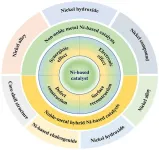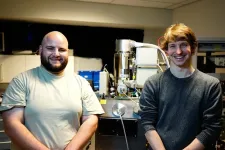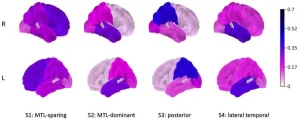(Press-News.org) Osaka, Japan – Many commercial products such as food, cosmetics, and inks contain cellulose nanofiber (CNF) as a thickening agent. However, CNFs have some limitations that prevent their more widespread use. Now, researchers from Osaka University have demonstrated a method of dehydrating CNFs to a dense powder without affecting their three key properties. Their findings are published in Macromolecular Rapid Communications.
Video for your easy understanding
https://youtu.be/PAEd36v_SjI
CNFs are a popular thickening agent because small amounts in water have high transparency, high viscosity, and the viscosity can be controlled. However, the amount of CNF needed in water is very small, so the most efficient way of transporting CNFs is as a dry powder.
Sounds good, but how do we get CNFs into powder form? The water containing the CNFs can be boiled away, but the remaining fibers stick together and redispersing these clumps leads to liquids that are cloudy, unless a lot of energy is used to break up the clumps. If water is removed by freeze drying, the resulting CNF powder is quite fluffy and takes up a lot of space. It is also affected by static electricity, making it difficult to handle.
These are significant drawbacks in industries where efficiency affects profitability. Therefore, the research team from Osaka University devised an improved water-removal method, the first step of which is to form an ‘organogel’, a type of gel consisting partly of organic molecules.
“Our process involves taking a CNF paste in water and dehydrating it by stirring in ethanol,” explains corresponding author Masaya Nogi. “The ethanol is then removed at 30°C, which is a low and cost-effective temperature. After some processing, it can then be redispersed in water simply by stirring.”
The redispersed product was shown to retain the three key properties of CNF thickening agents. Its tunable viscosity was demonstrated by spraying it from a pump spray bottle. It was successfully sprayed from the nozzle, which requires a low viscosity, and the ejected droplets did not run from where they landed on an upright surface, which requires high viscosity behavior. Furthermore, the spray doesn’t generate dripping, which can be a problem with other sprays.
“The large scale of many industrial processes means that all process improvements can have a big impact on the bottom line,” says senior author Masaya Nogi. “Our method of powder creation retains all key properties of CNFs while also enabling effective handling and cheaper transport and storage.”
The ease of use of the organogel-derived CNF powders is expected to make them an attractive prospect for application in many areas, including in the food, cosmetics, and sanitation industries.
###
The article, “Evaporative Dry Powders Derived from Cellulose Nanofiber Organogels to Fully Recover Inherent High Viscosity and High Transparency of Water Dispersion,” was published in Macromolecular Rapid Communications at DOI: https://doi.org/10.1002/marc.202300186.
END
A new method to keep thickening agents tiny in transport and big in application
Researchers from SANKEN (The Institute of Scientific and Industrial Research), at Osaka University report a dehydration method for cellulose nanofibers that produces a dense powder while maintaining the unique properties of the thickening agent
2023-06-27
ELSE PRESS RELEASES FROM THIS DATE:
Two technology-based approaches that improved hand hygiene compliance are featured at infection prevention conference
2023-06-27
Orlando, Fla., June 27, 2023 – Hand hygiene is the simplest, most effective way to prevent the spread of infections in healthcare, yet healthcare worker adherence is often low. Infection preventionists at two health systems will present their successful hand hygiene interventions at the Association for Professionals in Infection Control and Epidemiology’s (APIC’s) Annual Conference in Orlando Florida, June 26-28.
University of Michigan Health sustains 95% hospital-wide hand hygiene compliance through creation ...
Updated guidance shows how hospitals should protect patients from resistant infections
2023-06-27
ARLINGTON, Va. (June 27, 2023) — A group of five medical organizations have released updated recommendations for the prevention of methicillin-resistant Staphylococcus aureus, known as MRSA, transmission and infection. MRSA causes approximately 10% of hospital-associated infections in the United States and such infections are associated with an increased risk of death. Certain infections caused by MRSA rose by as much as 41% during the pandemic after falling in preceding years.
Strategies to Prevent Methicillin-Resistant Staphylococcus aureus Transmission and Infection in Acute Care Hospitals provides evidence-based, ...
How secure are voice authentication systems really?
2023-06-27
Computer scientists at the University of Waterloo have discovered a method of attack that can successfully bypass voice authentication security systems with up to a 99% success rate after only six tries.
Voice authentication – which allows companies to verify the identity of their clients via a supposedly unique “voiceprint” – has increasingly been used in remote banking, call centers and other security-critical scenarios.
“When enrolling in voice authentication, ...
Synthesis of peripherally annulated phenanthroporphyrins
2023-06-27
Prof. Okujima, in collaboration with Prof. Kobayashi at Shinshu University, reported the synthesis, molecular structure, optical properties and electronic structure of unusual phenanthrene-fused porphyrins.
Precursor porphyrins fused with aryl-substituted bicyclo[2.2.2]octadiene afforded the corresponding arylbenzoporphyrins (arylBPs) by retro Diels–Alder reaction. Unusual phenanthroporphyrins were obtained via the intramolecular Scholl reaction of arylBPs. We analyzed the optical and electronic structures using magnetic circular dichroism spectroscopy and time-dependent density functional theory calculations.
Our ...
Recent progress of Ni-based catalysts for methanol electrooxidation reaction in alkaline media
2023-06-27
The study is led by Ligang Feng (School of Chemistry and Chemical Engineering, Yangzhou University).
The rapid development of the economy driven by the large consummation of traditional fossil fuels is not sustainable, and global attention is shifted to the utilization of renewable energy sources, and biomass fuels. Methanol is considered a good biomass fuel to realize energy storage and conversion, which is convenient for storage and transportation; more importantly, it is much safer than other fuels such as gasoline, diesel, and natural gas. In addition, it can be prepared with wide sources in low-cost and ...
Move over diamond. hBN is quantum’s new best friend.
2023-06-27
Diamond has long been the go-to material for quantum sensing due to its coherent nitrogen-vacancy centres, controllable spin, sensitivity to magnetic fields, and ability to be used at room temperature. With such a suitable material so easy to fabricate and scale, there’s been little interest in exploring diamond alternatives. But this GOAT of the quantum world has one Achilles Heel… It’s too big. Just as an NFL linebacker is not the best sportsperson to ride in the Kentucky Derby, diamond is not an ideal material when exploring quantum sensors and information processing. ...
Personalized dosing in prostate cancer treatment improves patient outcomes
2023-06-27
Chicago, Illinois (Embargoed until 3:45 p.m. CDT, Tuesday, June 27, 2023)—By monitoring early-response biomarkers in men undergoing 177Lu-PSMA prostate cancer treatment, physicians can personalize dosing intervals, significantly improving patient outcomes. In a study presented at the Society of Nuclear Medicine and Molecular Imaging 2023 Annual Meeting, early stratification with 177Lu-SPECT/CT allowed men responding to treatment to take a “treatment holiday” and allowed those not responding the option to switch to another treatment.
Approved by the U.S. Food ...
Genomics- and image-guided subtyping refines characterization of Alzheimer’s disease
2023-06-27
Chicago, Illinois (Embargoed until 4:05 p.m. CDT, Tuesday, June 27, 2023)—A new computational technique that combines genomic and tau PET imaging data promises a more personalized approach for subtyping Alzheimer’s disease. Based on a novel clustering framework using sparse canonical correlation analysis (SCCA), the integrated approach was successful in identifying four subtypes of Alzheimer’s disease and the top genes associated with each. This research was presented at the 2023 Society of Nuclear Medicine and Molecular Imaging Annual ...
A jaw-dropping conundrum: Why do mammals have a stiff lower jaw?
2023-06-27
From the 20-foot-long jawbones of the filter-feeding blue whale to the short, but bone-crushing, jaws of the hyena and the delicate chin bones of a human, the pair of lower jawbones characteristic of mammals have evolved with amazing variation.
But at first glance, having a single bone on each side of the head — which creates a stiff lower jaw, or mandible — doesn't appear to give mammals an advantage over other vertebrates, which have at least two and as many as 11 bones comprising each side of the lower jaw.
Crocodiles, for example, have an edge over hyenas when it comes to their bite strength relative to ...
New research by Sylvester Cancer shows unmet support needs can lead to worse clinical outcomes
2023-06-27
MIAMI, FLORIDA (June 27, 2023) – Cancer patients with unmet supportive care needs are more likely to experience worse clinical outcomes, including more emergency department (ED) visits and hospitalizations, according to new research from Sylvester Comprehensive Cancer Center at the University of Miami Miller School of Medicine.
The study, published June 21 in JAMA Network Open, also found that Black race, Hispanic ethnicity and factors such as anxiety, depression, pain, poor physical function and low health-related quality-of-life ...
LAST 30 PRESS RELEASES:
Jeonbuk National University study shows positive parenting can protect adolescents against self-harm
Surface-engineered ZnO nanocrystals to tackle perfluoroalkyl substance contamination
This new understanding of T cell receptors may improve cancer immunotherapies
A new fossil face sheds light on early migrations of ancient human ancestor
A new immunotherapy approach could work for many types of cancer
A new way to diagnose deadly lung infections and save lives
40 percent of MRI signals do not correspond to actual brain activity
How brain-inspired algorithms could drive down AI energy costs
Gum disease may be linked to plaque buildup in arteries, higher risk of major CVD events
Contrails are a major driver of aviation’s climate impact
Structure of dopamine-releasing neurons relates to the type of circuits they form for smell-processing
Reducing social isolation protects the brain in later life
Keeping the heart healthy increases longevity even after cancer
Young adults commonly mix cannabis with nicotine and tobacco
Comprehensive review illuminates tau protein's dual nature in brain health, disease, and emerging psychiatric connections
Book prepares K-12 leaders for the next public health crisis
Storms in the Southern Ocean mitigates global warming
Seals on the move: Research reveals key data for offshore development and international ecology
Sports injuries sustained during your period might be more severe
World's first successful 2 Tbit/s free-space optical communication using small optical terminals mountable on satellites and HAPS
Can intimate relationships affect your heart? New study says ‘yes’
Scalable and healable gradient textiles for multi‑scenario radiative cooling via bicomponent blow spinning
Research shows informed traders never let a good climate crisis go to waste
Intelligent XGBoost framework enhances asphalt pavement skid resistance assessment
Dual-function biomaterials for postoperative osteosarcoma: Tumor suppression and bone regeneration
New framework reveals where transport emissions concentrate in Singapore
NTP-enhanced lattice oxygen activation in Ce-Co catalysts for low-temperature soot combustion
Synergistic interface engineering in Cu-Zn-Ce catalysts for efficient CO2 hydrogenation to methanol
COVID-19 leaves a lasting mark on the human brain
Scientists use ultrasound to soften and treat cancer tumors without damaging healthy tissue
[Press-News.org] A new method to keep thickening agents tiny in transport and big in applicationResearchers from SANKEN (The Institute of Scientific and Industrial Research), at Osaka University report a dehydration method for cellulose nanofibers that produces a dense powder while maintaining the unique properties of the thickening agent









